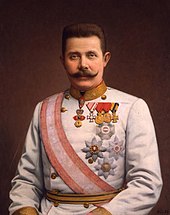Wilhelm Vita
Wilhelm Vita (born May 5, 1846 in Zauchtl , † August 1, 1919 in Vienna ) was an Austrian genre and portrait painter .
life and work
Wilhelm Vita studied at the Vienna Academy from 1862 to 1867 , his teachers were Johann Nepomuk Geiger , Eduard von Engerth , Karl von Blaas and Heinrich von Angeli . From 1870 Vita chose Vienna as a permanent place of residence, no study trips are documented. He portrayed Anton von Schmerling and Thaddäus Peithner von Lichtenfels , among others . Later he also received commissions from the imperial family, for example he portrayed Crown Prince Rudolf and Emperor Franz Joseph several times , as well as Archduke Karl Ludwig and Archduchess Margarete asAbbess of the public women's monastery on Prague's Hradcany .
A work that is now in the so-called “Sarajevo Hall” of the Vienna Museum of Military History deserves special attention . The painting shows the Austrian heir to the throne Archduke Franz Ferdinand in a white gala tunic with the rank of field marshal and with the four grand crosses of the Maria Theresa Order , the Imperial Order of St. Stephen and Leopold as well as the Order of the Iron Crown . With the exception of the Order of St. Stephen, these are all attributes that Franz Ferdinand as archduke and heir to the throne was not allowed to, but which he would have applied in the event of an accession to the throne. The painting was probably taken as part of preparatory measures by Wilhelm Vita, who was highly valued in court circles as a painter of official portraits. It therefore represents Franz Ferdinand as emperor and may have been intended as a template for official images of the emperor in schools or on postage stamps and the like in the event of his accession to the throne. After the assassination of the heir to the throne, the portrait, which had become a utopia, was painted over to such an extent that it again corresponded to the real past. In this condition, the painting was acquired from private ownership by the Army History Museum in 1959 and restored to its original condition after the overpainting was removed. Today it vividly shows the difference between the Archduke's wishful thinking and reality.
From 1870 Vita was a member of the Vienna Künstlerhaus . In 1889, based on the Paris exhibition “ Salon des Refusés ”, he founded the so-called “Salon of the Rejected”, from which in 1891 the Vienna Artists' Club emerged.
Works (excerpt)
- Portrait of Archduke Franz Ferdinand . Oil on canvas, around 1910, 78.5 × 72.5 cm. Army History Museum , Vienna.
- Portrait of Emperor Franz Joseph I of Austria . Oil on canvas, 1914, 240 × 133 cm. Army History Museum, Vienna.
- Portrait of Emperor Franz Joseph I of Austria . Oil on canvas, 1896, 128 × 91 cm. Army History Museum, Vienna.
- Portrait of Crown Prince Rudolf of Austria . Oil on canvas, 1883, 220 × 127 cm. Army History Museum, Vienna.
- Portrait of Crown Prince Rudolf of Austria . Oil on canvas, 1882, 145 × 82 cm. Army History Museum, Vienna.
literature
- Constantin von Wurzbach : Vita, Wilhelm . In: Biographisches Lexikon des Kaiserthums Oesterreich . 51. Part. Imperial-Royal Court and State Printing Office, Vienna 1885, p. 70 f. ( Digitized version ).
- Vita, Wilhelm . In: Hans Vollmer (Hrsg.): General lexicon of fine artists from antiquity to the present . Founded by Ulrich Thieme and Felix Becker . tape 34 : Urliens – Vzal . EA Seemann, Leipzig 1940, p. 424 .
- Heinrich Fuchs: The Austrian painters of the 19th century. Volume 4, Vienna 1979, p. K 108.
Web links
Individual evidence
- ^ Manfried Rauchsteiner , Manfred Litscher (Ed.): The Army History Museum in Vienna. Graz, Vienna 2000, p. 56 f.
- ↑ Johann Christoph Allmayer-Beck : The Army History Museum Vienna. The museum and its representative rooms. Salzburg 1981, p. 52.
- ^ Heinrich Fuchs: The Austrian painters of the 19th century. Volume 4, Vienna 1979, p. K 108.
- ^ Vita, Wilhelm . In: Hans Vollmer (Hrsg.): General lexicon of fine artists from antiquity to the present . Founded by Ulrich Thieme and Felix Becker . tape 34 : Urliens – Vzal . EA Seemann, Leipzig 1940, p. 424 .
| personal data | |
|---|---|
| SURNAME | Vita, Wilhelm |
| BRIEF DESCRIPTION | Austrian portrait painter |
| DATE OF BIRTH | May 5, 1846 |
| PLACE OF BIRTH | Breeding |
| DATE OF DEATH | August 1, 1919 |
| Place of death | Vienna |

